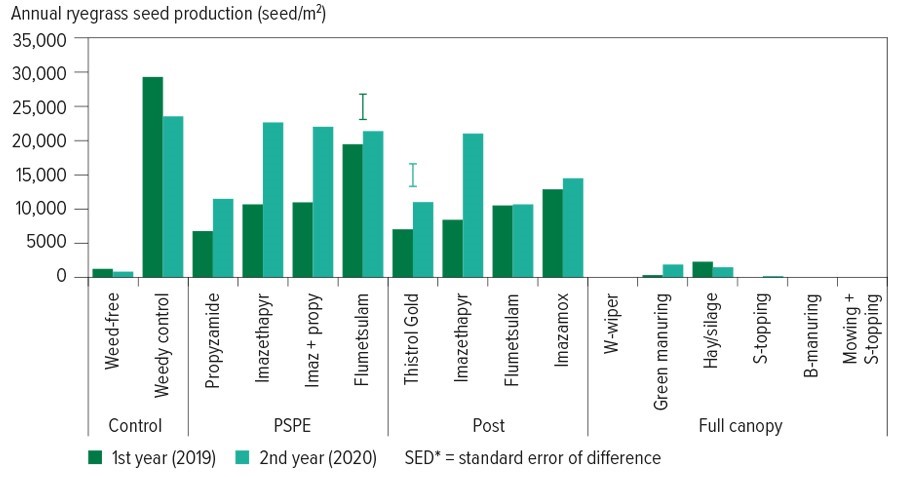While continuous cropping has proven to be a profitable option to more traditional mixed-farming systems, weeds and their ability to evolve herbicide resistance represent a serious threat to the productivity of Western Australian grain growing paddocks.
Weed seedbanks that have reached damaging densities – as high as tens of thousands of seeds per square metre – have been documented by researchers at the Australian Herbicide Resistance Initiative (AHRI) located at the University of Western Australia (UWA).
To cope with these extreme weed densities, some growers are attempting to exhaust their weed seedbanks by introducing a multi-year pasture phase using the legume serradella (Ornithopus sativus Brot.).
Now a team of researchers headed by AHRI’s Dr Mike Ashworth has analysed different weed control options and outcomes that are made possible while growing serradella for pasture or for nitrogen fixing cover.
“With continuous cropping, weed seed banks are increasing to problematic levels due to herbicide resistance and changing weed dormancy and flowering patterns,” Dr Ashworth says. “Short term pasture phases offer the opportunity to disrupt these populations by offering alternate weed control opportunities.”
The work was driven by GRDC investment, with trial studies led by AHRI’s Dr Yaseen Khalil.
Also taking part are Roberto Lujan Rocha from AHRI, Dr Angelo Loi from the Department of Primary Industries and Regional Development (DPIRD) and Dr Zhanglong Cao from Statistics for the Australian Grains Industry (SAGI West) at Curtin University.
Dr Khalil says the value of a pasture phase for weed management increases at higher ryegrass seed burdens and where herbicide resistance limits the efficacy of in-crop weed control. However, due to seed dormancy, multi-year pasture phases are typically required to reduce the size of the weed seedbank.
“Serradella is an aerial-seeded, annual legume pasture species that is well adapted to sandy, acidic soils typical of the Western Australian grain belt,” Dr Khalil says. “It is well suited to grow tactically within a crop rotation as its seed can be collected using a cereal harvester, significantly reducing the cost of subsequent establishment.”
He adds that when moving from a cropping to a pasture phase, serradella provides more potential options for using different herbicide groups to control weeds: “Growers can then select from a range of early and late interventions plus selective or non-selective applications,” he says. “A range of non-herbicidal options are also available.”
Weed-busting trials
Studies were conducted between 2019 and 2020. The aim was to evaluate all weed control options available in serradella, include chemical and non-chemical options and do it systematically to provide a fundamental dataset to assist growers (Figure 1). Control options that worked well when applied later in the pasture included:
- Weed wiping using glyphosate;
- Spraytopping using paraquat;
- Mowing followed by spraytopping 1 week later;
- Cutting for hay/silage production;
- Green manuring; or
- The non-selective use of glyphosate prior to the weeds flowering (brown manuring).
“We found that in situations where weed densities are very high, sowing Cadiz (PBR) and brown manuring by the end of the season can significantly drive down the ryegrass seedbank,” Dr Khalil says.
While these techniques were highly effective at reducing annual ryegrass seed production, they also greatly reduced serradella pod production.
“We consistently found that weed control options that are focussed on reducing the viability of annual ryegrass were the most effective,” Dr Khalil says. “However, they reduced serradella pod production highlighting that these treatments are not the best when establishing a longterm serradella phase.”
As serradella is cheap to establish from grower retained seed, growers may opt to use effective techniques, such as brown manuring, on sites with large ryegrass seed banks and re-establish the pasture phase.
Table 1 - Annual ryegrass seed production

Source: AHRI
Conversely, herbicides applied at either post sowing pre-emergent (PSPE) or at the post-emergent (POST) stage were far less effective. Propyzamide was found to be the most effective herbicide treatment applied at the PSPE timing, reducing annual ryegrass seed production by 59 per cent in 2019 and 40 per cent in 2020.
In comparison, imazethapyr reduced annual ryegrass seed production by 23 and 30 per cent, respectively. When these two chemistries were applied sequentially in a double knock, ryegrass seed production was reduced by 72 and 82% in 2019 and 2020 respectively. This level of control was not significantly improved when these herbicides were applied at the later timing.
The highest serradella seed pod production was achieved with the application of flumetsulam followed by the PSPE application of propyzamide and/or imazethapyr.
Understanding ryegrass seed banks
Overall, the study found that there are effective tools to control ryegrass in pasture phases. Short term pasture phases offer growers a unique opportunity to rapidly put ryegrass seed banks into steep decline.
“Informed by multiple biological studies, the RIM (Ryegrass integrated management) model indicates that growers need to get three years of full ryegrass seed set control to dramatically reduce ryegrass seed banks in the soil,” Dr Khalil says. “Serradella pasture phases provide this opportunity whilst biologically fixing nitrogen and reducing soil nematode populations.”
More information: Yaseen Khalil, yaseen.khalil@uwa.edu.au

























































